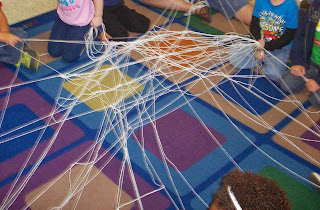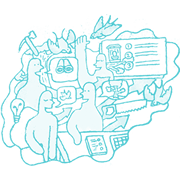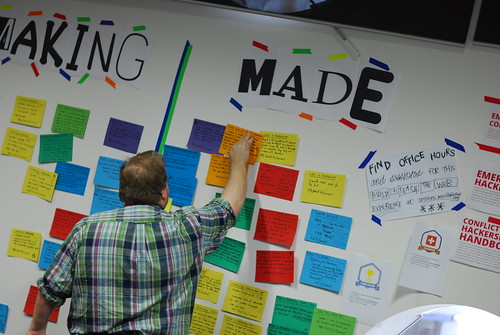A Strong Wind Blows

You can play this game with literally any topic you want. It's always fun, always funny. Pro tip: Watch out for the over enthusiasm, people might break chairs, run into each other or fall down with this knowledge sharing technique!
Collaborative Explorations

This activity is designed to help people reflect. You can replace "Making as Learning, Connected Learning and the Open Web" with something else, for example "Environmental policy, Non-violent demonstrations and lobbying your government". Use an infographic or a framework to help participants understand overarching concepts.
Collaborative Mindmapping

Mindmapping can help participants generate ideas. Give attendees a specific topic or question to think about to help them focus.
Defining Problems

This Collaborative Mindmapping activity centers around defining problems.
Evolution for Geeks

A fun and strange game that gets people moving and interacting. You can replace the "god" character with a hero relevant to your group. You can also replace the specific evolutionary stages with something more relevant to your group. For example, if you're working in human rights, you might use an evolution from Education to Empowerment to Employment to Activism. Be creative!
Introductions

A basic way to start a workshop using a collaborative document and badges. (Learn about badges here!!) This facilitation method will help you when there are loads of people in the room, and introductions need to be short and sweet.
Mingle Mesh

A ball of yarn and a circle of people can lead to a fascinating discussion. Ask participants questions and have them throw the ball around to whomever wants to respond. You'll build a web of connections.
Mini Makers Scrum

Find out what your workshop participants want to make and then create an atmosphere in which they can make it! This activity uses Webmaker tools, but you can remix it to work for any tool.
Mobile Basics

A series of questions and pointers to help you start a workshop where mobile devices are a theme. Includes a section on trust surrounding app install.
Role Playing: Teach a Skill
Break into pairs or tiny groups and have people role play teaching and learning. This activity creates a safe space and helps people know their input is welcome.
Setting Learner Centric Objectives
Find out what your workshop participants expect from the day/week and then co-create the agenda by comparing your plan with what the participants want.
Sort Yourselves

This activity can help a facilitator judge what kind of skills are in the room. Instead of asking people to sort themselves by "digital making" experience, you can have them organize by something else. For example, by number of campaigns launched or experience building furniture.
Spectrogram: Exploring Pedagogy

A Spectogram is a discussion tactic in which participants spread out along a continuum to voice their opinion to a specific statement. This version asks learners to think about participatory methodologies.
Spectrogram: Understanding Privacy

This Spectrogram activity helps you facilitate a discussion around privacy.
Spectrogram: For Closing Circle

End your workshop with a discussion centered around learning objectives and how people felt about your session.
Speedgeek Connecting

This activity creates and open space to play with different projects in a speedy format. This initial connected learning experience helps people get their feet wet with these kinds of pedagogies.
Speedgeek Playtesting

Use this activity to quickly share things people have made or produced with others at an event.
Story Exquisite Corpse
This activity helps break the creativity ice and gets people thinking about story mechanisms.
Unpacking Fundraising with Apps

This activity will help you facilitate small group discussions around fundraising in connection with mobile apps, while documenting that discussion and surfacing overarching themes within the larger group.